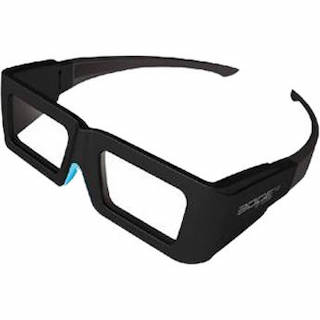![]() Founded in 2007, Volfoni has grown to become one of the major companies in the stereoscopic 3D cinema market. Importantly, Volfoni is one of the only companies in the world to be endorsed by all the major Hollywood studios for the quality of both its active and passive 3D technologies. A French company with a global presence, Volfoni’s principal headquarters are in Paris, its research and development offices are in the south of France, and it has sale’s offices in countries around the world. Volfoni recently created a joint venture in China to more effectively penetrate the Chinese market. Araceli Vaello has been the company’s chief commercial officer for more than a decade and remains excited about the industry and the potential for 3D. As she says, “The passion I feel for this industry just keeps on growing, even more if possible, each day.” Adding to her excitement, is the fact that late 2022 and early 2023 has seen the release of several 3D feature films have gone on to major success at the box office. I recently spoke with Vaello via email and our conversation started there.
Founded in 2007, Volfoni has grown to become one of the major companies in the stereoscopic 3D cinema market. Importantly, Volfoni is one of the only companies in the world to be endorsed by all the major Hollywood studios for the quality of both its active and passive 3D technologies. A French company with a global presence, Volfoni’s principal headquarters are in Paris, its research and development offices are in the south of France, and it has sale’s offices in countries around the world. Volfoni recently created a joint venture in China to more effectively penetrate the Chinese market. Araceli Vaello has been the company’s chief commercial officer for more than a decade and remains excited about the industry and the potential for 3D. As she says, “The passion I feel for this industry just keeps on growing, even more if possible, each day.” Adding to her excitement, is the fact that late 2022 and early 2023 has seen the release of several 3D feature films have gone on to major success at the box office. I recently spoke with Vaello via email and our conversation started there.
Digital Cinema Report: In recent months, stereoscopic 3D movies have done extremely well at the box office. I’m thinking of films like Avatar: The Way of Water, Jurassic World Dominion, and Doctor Strange in the Multiverse of Madness. In your mind, what is the unique appeal of a 3D movie?
 Araceli Vaello: I agree that the latest results from 3D movies have been extraordinary, but I still think we are far behind what can be achieved with 3D technology because the potential is huge.
Araceli Vaello: I agree that the latest results from 3D movies have been extraordinary, but I still think we are far behind what can be achieved with 3D technology because the potential is huge.
The studios woke up after the box office results of Avatar: The Way of Water as it’s been proven that when you invest money into making a good, quality movie in 3D, the public appreciate it. Following its box office success, I’ve read several times that the studios plan to invest much more into making quality 3D movies, which is the future of cinema, however, it’s not only the studios’ responsibility to ensure the final result is adequate.
Exhibitors must be aware that if studios invest into making quality 3D movies, they should also invest in renovating equipment, upgrading their rooms, maintaining the screens and, in general, making sure they get enough light on the screen, so audiences feel what the directors have tried to convey.
Focusing on Avatar (as the best possible reference), the depth, clarity and sharpness made viewers feel like they were inside the movie at all times. That was the success of Avatar, and that is the secret of 3D; taking you to a parallel reality in which you are part of the movie and which you cannot experience at home.
When an exhibitor doesn't get the expected results with a 3D movie, before blaming the technology or assuming the consumer didn’t like the experience, which has happened in Europe, they have to first review whether their 3D offering is adequate. For example, if the glasses are not of high quality, they may produce terrible ghosting and therefore headaches. If the screen lacks light, the viewer may not feel the depth or purpose of the 3D. If the systems are old, they may not get the expected effect by the filmmakers. There could be many factors, but it has been proven that in each cinema where there's been an investment in 3D and technology has been updated, the return on investmemt has been amazing.
 To give you an example, the biggest sales we made for the Avatar sequel were in active solutions, not passive 3D. Exhibitors were not ready for a good 3D movie. The majority of them didn't have silver screens for the Passive 3D to work as they had removed them in the past, which reinforces the notable lack of investment by many cinemas, predominantly in Europe, to support a great movie with these characteristics. However, with the right investment into high quality technology and desire to cater to consumers with renewed hunger for 3D, exhibitors can deliver the experience expected by audiences and movie creators.
To give you an example, the biggest sales we made for the Avatar sequel were in active solutions, not passive 3D. Exhibitors were not ready for a good 3D movie. The majority of them didn't have silver screens for the Passive 3D to work as they had removed them in the past, which reinforces the notable lack of investment by many cinemas, predominantly in Europe, to support a great movie with these characteristics. However, with the right investment into high quality technology and desire to cater to consumers with renewed hunger for 3D, exhibitors can deliver the experience expected by audiences and movie creators.
DCR: Volfoni's technology has been endorsed by all the Hollywood studios. How did that come about and why do you think that matters?
AV: Today it is very important that the studios know and endorse your technology because, although there are many 3D manufacturers, not everything is valid or of the quality that studios require for their masterpieces.
It doesn’t make sense to invest so much into a high-quality movie simply for the cinema to install low quality products that give a bad result or negative reaction from the public. Therefore, the studios take this issue very seriously. With cheaper products, like passive 3D glasses, it is impossible to have the expected result because the lenses are usually very thin and therefore produce tremendous ghosting; something exhibitors may not consider or be aware of if they don’t carry out optical tests when installing the systems.
Good technology is not given away, and it is important that people trust and follow the recommendations of the studios who are looking for the best results for their productions.
 DCR: German filmmaker Wim Wenders presented his new documentary Anselm in 3D at the Cannes Film Festival this year. His film was shot and projected in 3D. It's his fourth 3D feature and he has a fifth 3D film in the works. That strikes me as a sign that more filmmakers are beginning to see the artistic possibilities of the stereoscopic format. ls that your impression?
DCR: German filmmaker Wim Wenders presented his new documentary Anselm in 3D at the Cannes Film Festival this year. His film was shot and projected in 3D. It's his fourth 3D feature and he has a fifth 3D film in the works. That strikes me as a sign that more filmmakers are beginning to see the artistic possibilities of the stereoscopic format. ls that your impression?
AV: This is really interesting and clearly what makes the difference. As you say, Wim Wenders shoots in native 3D. And there's the key; native 3D.
Five years ago, I was contacted by some Hollywood studio 3D experts who were very afraid that 3D was slowly dying, especially in the USA where the entrance price for 3D content is high, and they wanted to reboot the industry as they were sure it was being addressed in the wrong way (they were not wrong), and they needed our help.
We're sure about one thing which has already been proven: people do not like the 2D/3D convergence process and paying huge prices to enter movie screenings they're not sure of. But of course, the ticket price is not only a problem of the studios, but of the 3D companies who also charge crazy fees for the use of their 3D systems. Everything adds up and it's not worth it for people to pay so much money for a badly converted 3D film or for the exhibitor to earn so little as all of this will go to licensing and rental fees, meaning very little revenue.
Shooting native 3D is infinitely nicer. It is completely affordable now to produce pure 3D.
Many years ago, it was too expensive which is why many studios decided to go to conversion, which I personally think was a bad idea as it only hindered the 3D industry. But now, the conversion process is too expensive – three to four million for a feature length movie – and shooting in 3D can now be done for the same price as regular film or HD, which is helping filmmakers consider shooting in this way again. As an example, the marvelous James Cameron is shooting all of his new Avatar movies in native 3D with some conversion for the big, complicated action scenes, and this is the key to the success of his movies.
This will help to reboot the industry, and the fact that 3D movies are affordable to produce now is the reason why there's a trend for filmmakers to shoot in 3D again.
 Sadly, Ang Lee and James Cameron are mainly the only big directors who still embrace native shooting at the moment. Independent and medium budget film makers worldwide still shoot native 3D. This is also a great opportunity for medium budget 3D movies to get into the theatres. The licensing on these [is] not high compared to the licensing fees of the big studios. Theatres can then charge a regular price for tickets to bring more people to the cinemas and bring back the passion for this incredible technology.
Sadly, Ang Lee and James Cameron are mainly the only big directors who still embrace native shooting at the moment. Independent and medium budget film makers worldwide still shoot native 3D. This is also a great opportunity for medium budget 3D movies to get into the theatres. The licensing on these [is] not high compared to the licensing fees of the big studios. Theatres can then charge a regular price for tickets to bring more people to the cinemas and bring back the passion for this incredible technology.
DCR: What do you see as the next big trends for Volfoni?
AV: Volfoni's amazing technical team is constantly working to find new and improved technologies for the 3D market. As you know, we work both in the cinema and the professional industry, helping us to be focused in improving the optical performances of our products and provide the best quality.
We're now very focused on the trend of VR and LED screens. We're already working with the biggest LED suppliers worldwide and, as we expect this technology to boom over the coming years, we're improving all of our systems and updating all of our Active products to be fully compatible, ensuring they are the best choice for use with LED and other future trends.
We are working on other projects, but it's too soon to speak openly to the market about other products coming.
DCR: And what do you envision will be the next big trends for the motion picture industry as a whole?
AV: Audiences' behavior is evolving, and people are consuming media in different ways than they have been doing in the past. For example, younger generations are more likely to stream content anywhere (even from their mobiles) and are less likely to go to the theatres. This shift in behavior is already impacting the future of theatrical distribution for movies.
This has made all of the film industry and filmmakers shake and think about how to drag these consumers back to the movies which is why cinemas are starting to offer experiences people cannot have at home. The industry is being innovative and adaptable to meet the changing needs and preferences of the younger audiences.
Movies will become more immersive. Advancements in technology will allow filmmakers to create unique visual effects which will allow people to immerse themselves in a story by putting them inside the world of the film. Augmented reality will also let viewers see the real world through the eyes of characters in a film which is nothing we've seen before in a cinema. These 3D technologies allow us to interact with our movie characters in ways that were never possible before. This is one of the most important trends I believe filmmakers will track over the coming years and will likely change the way movies are made and experienced.
There's also a push to make screens larger, think premium large format, and to introduce new technologies like LED screens, which is something you definitely could not achieve at home and will make the experience even more immersive and complete.
Finally, the scary artificial intelligence is also proving to provide an insight into audience preferences, predicting box-office performances and even generating unique content.
Theatres will need to find ways to make people feel special with a combination of premium amenities, high-quality food, and beverage offerings, as well as interactive and immersive technology like virtual reality and augmented reality. Anything to make going to the movies stay special and different to being home. Of course, I don't think this is an overnight move, but I am sure in the next ten years we're going to see very big changes.
